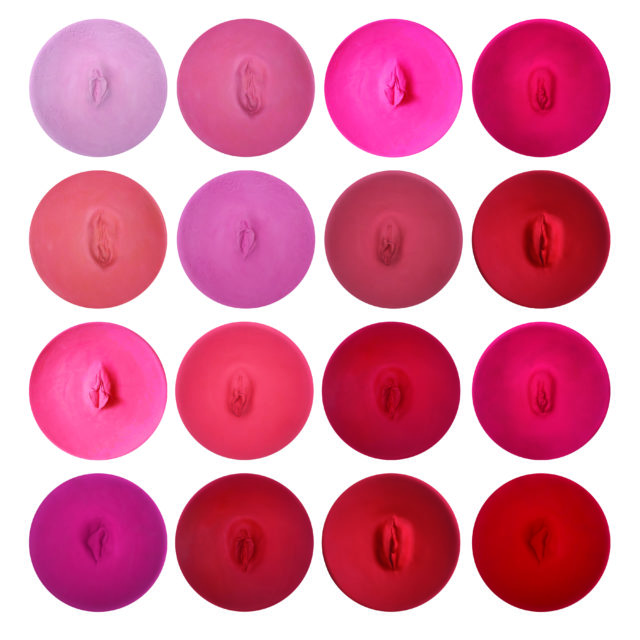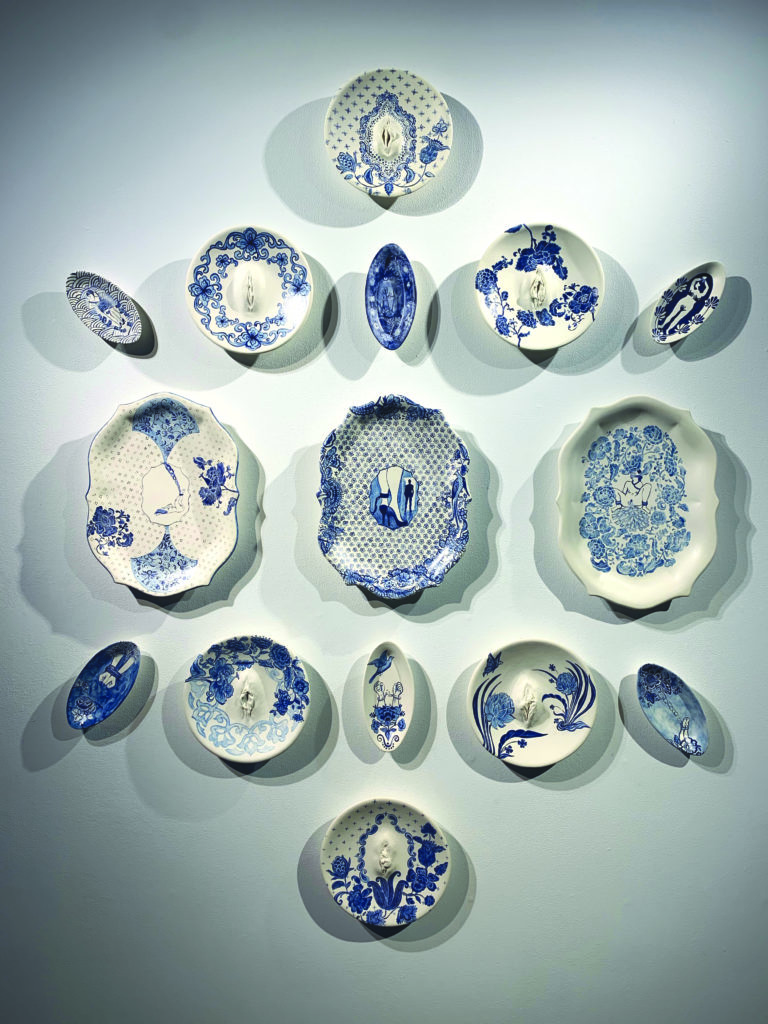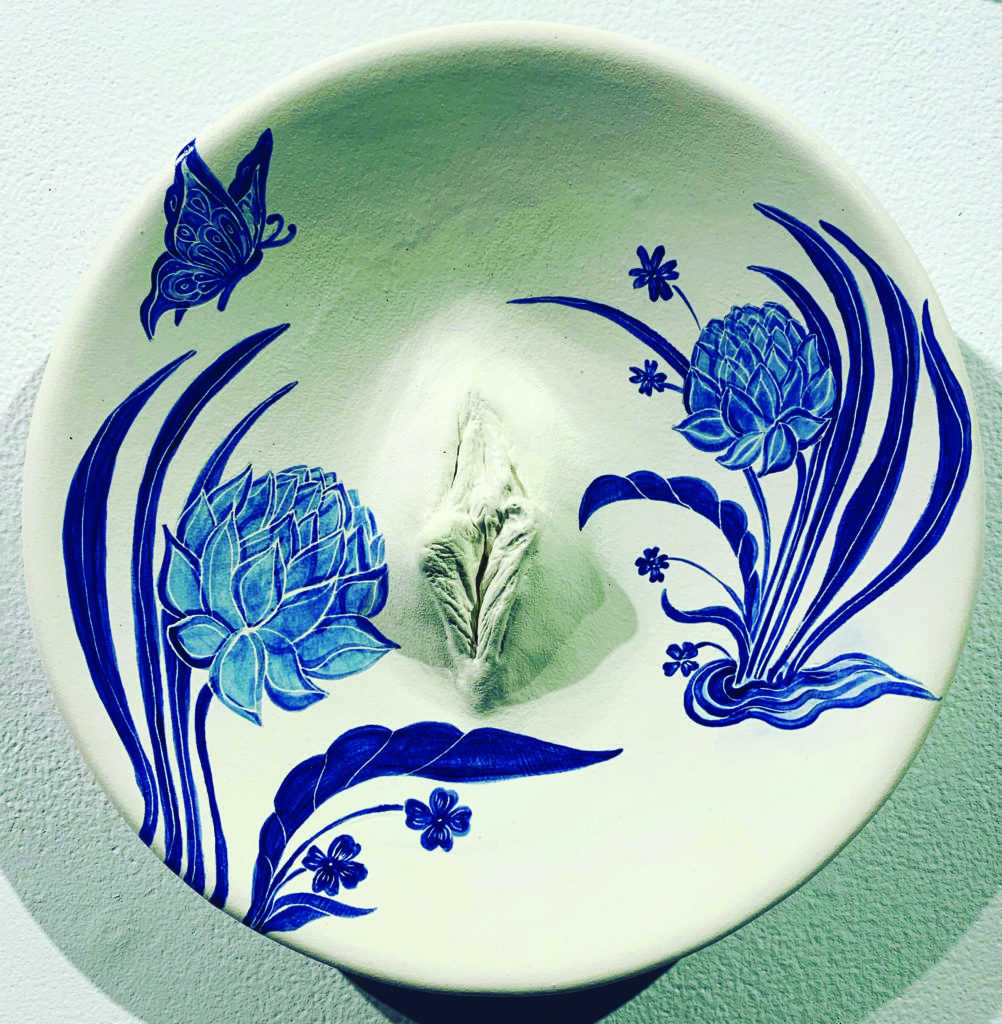
In the months leading up to the 2016 presidential election, Boulder-based artists Julie Maren and Joy Alice Eisenhauer were excited. The two had partnered up to create the Women’s Art League and collaborate on a new project. Anticipating the election of the first female president, their idea was simple: Since incoming presidents get to select a set of china for the White House, Maren and Eisenhauer would give their prospective candidate a bold option.
“We were being kind of cheeky and thought, let’s create vagina china!” Maren says. “We wanted to celebrate having our first female president in a fun way.”
But their celebratory project took a dark turn.
“[After] the presidential election, we were all in such shock,” Maren says. “It was traumatic and depressing to see everything that I thought was moving forward actually feel like it was going backwards. So it was a tremendous motivating force. I had to do [the project] just to help myself feel sane and to speak out about what was happening.”
Their idea remained the same — to create casts of vulvas and mount them on plates — but instead of one commemorative set, Maren and Eisenhauer used Vagina China as a way to delve into contemporary women’s issues. So far, they’ve created four different sets dealing with resistance, pleasure, wage inequality and sex trafficking. They’ve drawn on classic pottery trends from Greek antiquities for “Flower of Life” and traditional blue-and-white patterns for “The Silk Road,” which is now on display at Metro State University’s Center for Visual Art through Oct. 19.
“The Silk Road” features multiple plates mounted on a wall. From far away, the blue-and-white designs seem typical, but upon closer inspection the paintings on the plates feature women in chains, being groped and shooting money out of intimate areas of the body. Scattered among these are plates with realistic vulvas rising from the center. The title of the piece calls back to the historic trade route threading between Asia, the Middle East and Europe that was used, in part, for sex trafficking, a problem that still plagues the world today — including Denver, as the artist statement notes.

The imagery of the female anatomy presented tacitly on a plate is poignant. It’s a part of the body that is hidden and not spoken about, just like many of the topics examined with Vagina China are hidden and not spoken about. By using such evocative images, Maren and Eisenhauer hope to draw people in and increase awareness about taboo, misunderstood or underrepresented subjects.
“It’s provocative,” Eisenhauer says. “The name Vagina China makes people raise an eyebrow and pay attention. We want people to pay attention”
The first set of plates, titled “Vulva la Résistance,” was inspired by the Women’s March and the emblematic “pussy hat.” The trend of using female anatomy to push back against patriarchy and to symbolize women’s rights may come from the vulva’s historically multifaceted symbolism. In Vagina China, it represents revolution, pain, pleasure, inequality and power. Just as women’s bodies have frequently been objectified, activists and artists like Maren and Eisenhauer are flipping the script to control the narrative and put the vulva, and in turn women’s issues, on display.
“Yes, in some way this work is hyper objectifying the image of the vulva,” Eisenhauer says. “But it’s the real image of what women look like, and we’re putting it in a place of honor and contextualizing it with societal issues that affect women. It’s so important to know our bodies and be able to claim our bodies and be empowered in our bodies.”

Part of their goal is to demystify female anatomy. The artists wanted to showcase the diversity of women. After the election, they learned more about the issues affecting women, and grew concerned at how labiaplasty surgery was gaining popularity, which they credit to a lack of “real” representation of female anatomy in media.
“A lot of imagery that’s out there has been altered. A lot of imagery people see has been airbrushed,” Eisenhauer says. “One of the fastest-growing surgeries in the world is labiaplasty. [Mostly] young women from 18–25 years old are cutting off their labia because they don’t realize what women look like, that they’re not supposed to look like a barbie doll. We were just blown away by this information. It’s horrific. It’s like every part of the body. We are all different. And to be able to really show this in a beautiful and honoring way was important for us.”
Vagina China is the newest iteration in a long line of feminist art. There’s a clear lineage drawn from the work of Judy Chicago and her piece “The Dinner Party.” As a young artist starting out in the ’70s, Chicago noticed a lack of women in history books or in positions of power in the art world. In “The Dinner Party,” she attempted to revise history by setting a table with personalized place settings for significant historical women, including Emily Dickenson, Sacagawea and Sappho. Each woman’s plate depicts a sculptural representation of a vulva.
But this tradition goes even further back to the work of Virginia Woolf’s sister Vanessa Bell and her husband, Duncan Grant, who also created a set of plates in the early ’30s honoring important women. The set, entitled The Famous Women Dinner Service, was privately commissioned and was not shown publicly for decades; it features portraits including Marie Antoinette and Pocahontas. Along with “The Silk Road,” MSU’s exhibit includes a short film that chronicles the evolution from Bell to Chicago to Vagina China.
All of these artists essentially had the same goal: to remind society that women — not just men — played a role in creating society as we know it. The artists each use the female body to get their point across, but their methodology evolves with the times — from portraits to embellished representations to realistic casts of vulvas in plates.
Depicting the vulva in a realistic, unaltered way lends meaning and humanity to the issues presented in Vagina China. The pieces are potent in their explicitness. While sex trafficking is a crime so horrific it can feel unreal and incomprehensible to many, Vagina China brings the human element to the forefront by using this private, intimate body part. It’s not an easy-to-ignore statistic; each vulva plate was derived from a real woman, just as trafficking affects real women.

Presentation was important to the artists as well. Instead of a canvas or any flat surface, the artists chose to present the subject matter on dinnerware. Plates are traditionally thought of as women’s craft. Moreover, fine china is commonly associated with grandma’s house. It’s a reputation that suggests women are docile, delicate and fragile — but Vagina China subverts this and uses the china to hold a powerful, forceful message.
Plus, not only are the plates inviting the viewer into the topics, they’re offering women a seat at the table.
“Thinking about this project and Vanessa Bell and Judy Chicago, it’s taking these domestic objects out of the home and in many ways, it’s bringing women and women’s issue out into the world in this brighter, contextual level where we all belong,” Eisenhauer says.
“The personal is political” was a rallying cry for feminists in the 1970s. Vagina China builds on and modernizes that sentiment, making the intimate political as well.
ON THE BILL: ‘Vagina China’ is part of ‘Collectivism’ and is on display through Oct. 19 at the Center for Visual Arts at Metropolitan State University of Denver, 965 Santa Fe Drive, Denver.














